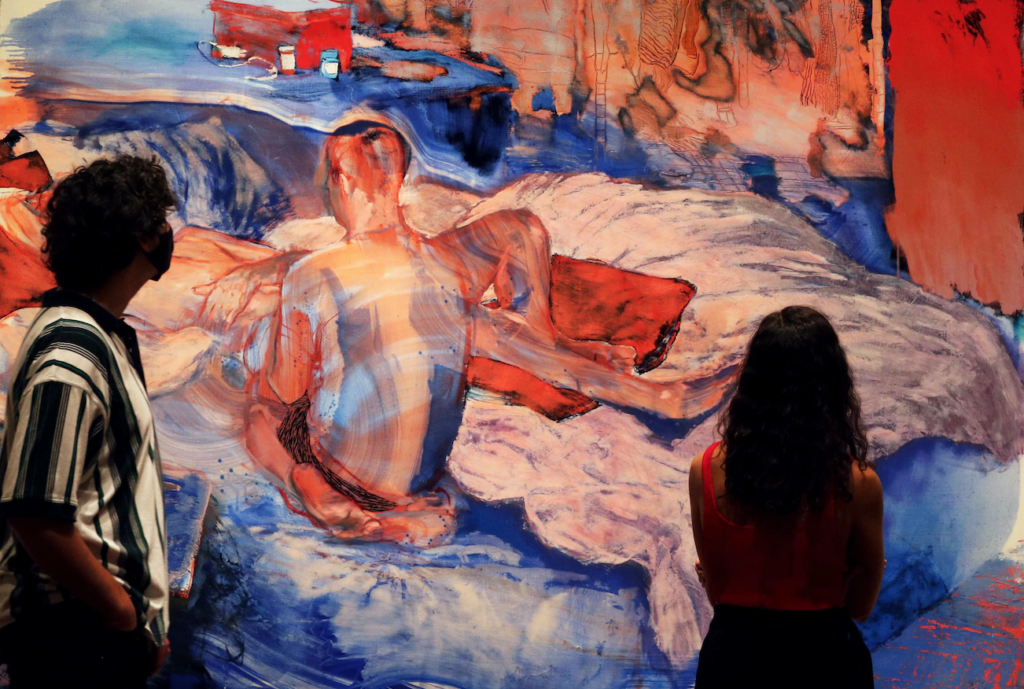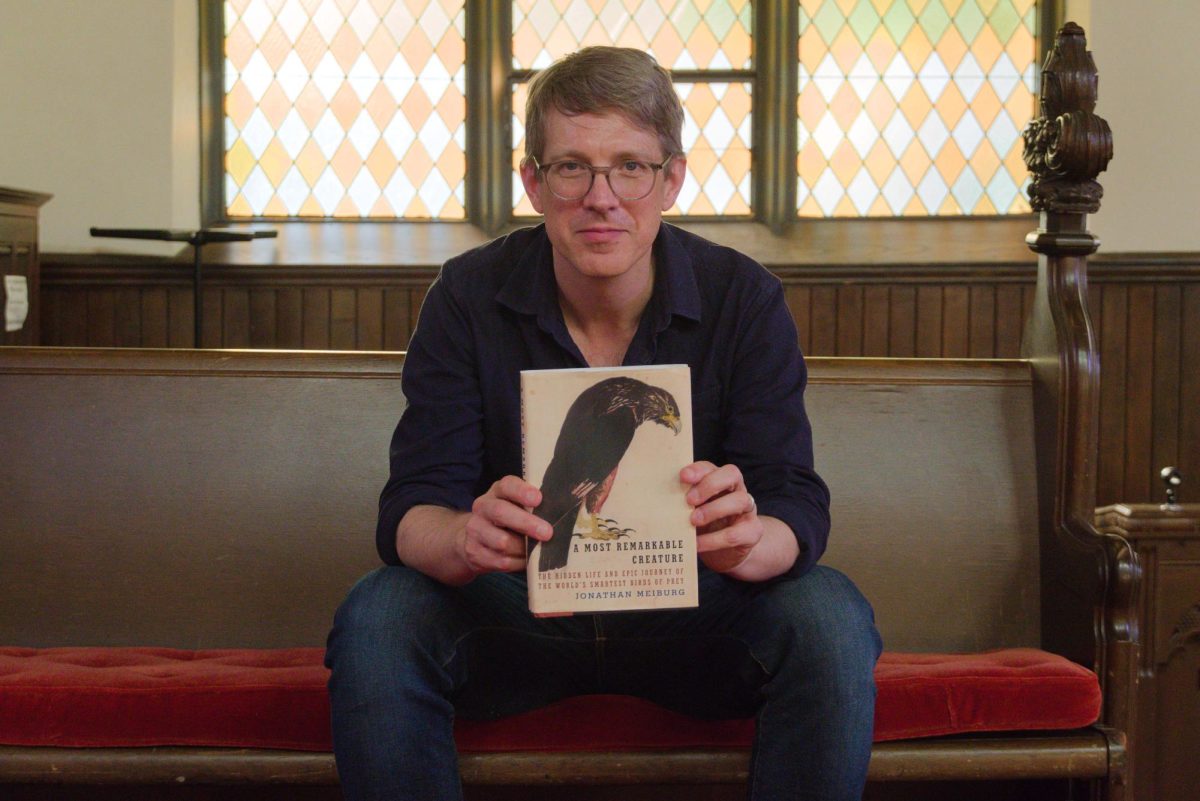Socks that artist Jeremy Laing darned last winter during quarantine hang on a Calder-like mobile in the Grinnell College Museum of Art (GCMOA). Worn over the years, the vestiges of the wear are threaded throughout, retracing the path of the everyday.
The exhibit where Laing’s socks are featured is “Queer/Dialogue,” a show that opened Sep. 4 at the Grinnell College Museum of Art, where it will remain until Dec. 12. Seven of the featured artists have work exhibited in the gallery while an eighth artist is only featured on the exhibition’s online viewing room. The online website also includes recorded conversations between the curators and five of the artists. Transcripts of the interviews are available.
The featured artists are Louis Fratino, Jordan King, Jeremy Laing, Doron Langberg, Catherine Opie, Christina Quarles, Paul Mpagi Sepuya and Devan Shimoyama. All of the featured pieces were created within the last 20 years.
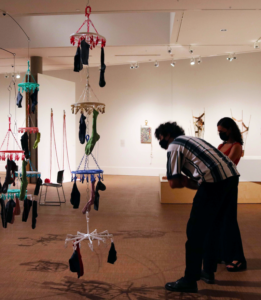
On Sep. 7, the Museum hosted a conversation and reception with Daniel Strong, a curator for the show and Grinnell College’s associate director of exhibitions, guest curator Greg Manuel, artist Jeremy Laing and Collections Manager Jocelyn Krueger.
The show features a significant quantity of artworks that range in scale and medium. “This is the first time I have felt that this gallery is too small,” Strong said. Most of the pieces came from private collections and were acquired recently from cities throughout North America.
The exhibition was originally supposed to open during the 2020-21 academic year. In 2019, Tucker Haddock `21 approached Strong in his office and suggested the Museum of Art stage a queer art exhibit. Strong immediately asked what Haddock meant by that. That question guided the curatorial process and is a focus of the exhibition itself. How can queerness be represented? What does it mean to be represented in art and why is that important?
Much of the featured art is not explicitly about queerness. “Instead of coming up with a definition or a theme, ‘What is queer art and what are queer artists?’, we decided to identify artists who identify as queer and present them individually, but in concert,” Strong said. “Each artist would have a space in which to share their work, and then the space as a whole would bring them together.”
Many of the works focus on aspects of everyday life, the mundane, the personal and the intimate, representing intersectional identities of race and gender. One piece by Doron Langberg, “Lovers,” depicts a bedroom scene in vivid, Fauvist-esque strokes of color, of two men: Langberg and an unidentified partner.
This is the first time I have felt that this gallery is too small. – Daniel Strong, Associate Director and Curator of Exhibitions
In a conversation with Strong and Toronto-based guest curator Greg Manuel, who has known Strong for around 10 years, Langberg described the idea of ephemerality behind this work. He explained how anything could disappear from our lives in a moment. This discussion took place in Langberg’s studio in New York, which Strong and Manuel visited in March 2020 days before LaGuardia and JFK suspended outgoing flights in response to the COVID-19 pandemic’s emergence in the United States.
The art in the exhibition, through different methods and media, investigates and portrays the interaction of the body in space and the embodiment of projected identities at the intersection of social, political and economic issues. The corporeal focus invokes sensations in the viewer.
This attention to the physical arises in the work of Christina Quarles’, who was trained in drawing but transitioned towards painting when she attended the Yale School of Art. Her work in the exhibition appears to navigate between the techniques of drawing and painting and references the human form.
Her pieces draw attention to the physical process of their creation. In an interview with the curators, a recording of which is available on the exhibition’s website, she described how drawing happens with the wrist and painting is with the arm. She also talked about her relationship with the society in which she is situated as a queer, biracial person who “reads” white. Quarles’ work explores perception of identity from the surface-level impression that is apparent when we initially present ourselves. Strong explained, “Her work, at least from my perspective, is about where the body meets the world.”
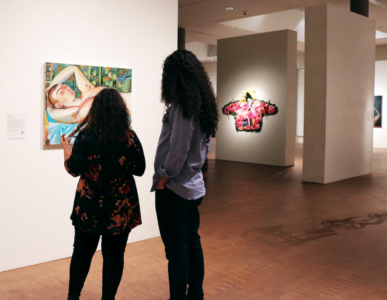
Meanwhile, Catherine Opie was among the first artists whose work Strong added to GCMOA’s official collection when he began his curatorship at Grinnell College in 1999. Opie contributed a short film to “Queer/Dialogue” titled “The Modernist.” More recent works of hers are on display, including photographs from 2016 that are related to the film.
Bringing the Jazz Ensemble into the gallery for the first time, visiting professor of music Daniel Oore asked the students: “What does it feel like to put my body in some of the figures I see?”
Oore believes that the jazz tradition and the concept of queerness are fluid in different ways, and “there’s a compatibility there.” They mentioned Billy Strayhorn and Duke Ellington’s variation of Tchaikovsky’s Nutcracker Suite, called “Sugar Rum Cherry,” recalling the “relationship to existing music in Black music traditions that has explicit and implicit relationships to queerness.”
Throughout the semester, Oore will regularly bring the Jazz Ensemble, which they direct, into the art gallery. During the first visit, the class had conversations about the works, and Oore led improvisation with a call-and-response structure.
Oore described jazz improvisation “starting with the body and using that as a foundation.” They think of music as an act of movement, which is related to the themes in the art and allows for personal connection to both. “Most things in the world are created through movement. If you have a sound it’s created through movement, and color in a painting is an act of putting light onto a canvass. … When we listen, we hear the traces of movement, and when we look, we see the traces of movement on a fundamental perceptive level.”
Devan Shimoyama’s pieces in the exhibit are both personal and externally focused. In one piece titled “Potted,” he sits in the backyard of his new home in the suburbs of Pittsburgh. Various fabrics and luminescent materials overlay the canvas in a collage-like appearance. Shimoyama’s gaze focuses on the observer. This piece calls to the experience of a young Black man living in a predominantly white suburb, recalling histories of redlining and the continuing issue of housing inequality.
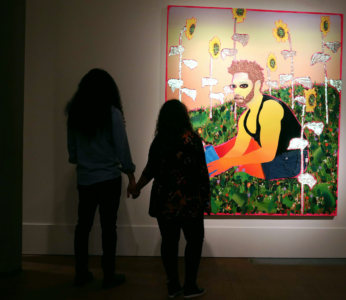
Another one of his pieces, “Untitled (For Trayvon),” pays tribute to Trayvon Martin, who was shot and killed by George Zimmerman in 2012 at age 17. Large flowers appear to bloom from the wall in the shape of a hoodie, and rhinestones line the inside of the hood. Shimoyama did not want to portray Black pain. Rather, in honoring Trayvon Martin he intended to commemorate the life and vitality that the young man embodied.
Jeremy Laing is a Toronto-based artist featured in the exhibition. With a background in fashion design, his pieces are made of textiles and fabrics. The vivid seams and threads are tactile and raw, personal without giving too much away. The sock mobile, “Ongoing Relation, Wear and Repair,” confronts the convention of modernist art displays. The art is dignified in itself and as it is situated on display in the gallery. The folded blankets that sit in stacks on the floor were the ones used to transport the textile sculptures exhibited next to them.
Zoë Yunger `22, who attended the conversation and reception on Friday, shared her perspective on the Laing piece: “I just really like that part of the exhibit is showing off the fact that the exhibit itself has many lives and can be used to ship safely the fragile pieces of itself. … It just takes on different roles, and that’s just like people. In different settings, you just take on a different register, and it’s beautiful.”
Strong hopes that the dialogues the exhibition engenders continue and extend past the Museum’s walls. He mentioned a class in the gender, women’s and sexuality studies department that will be offering extra credit to students writing alternative plaque descriptions for the exhibition’s pieces.
Several events will be held throughout the semester connected with the exhibition, including a Writers@Grinnell talk with the Grinnell College Mellon Fellow Santiago Jose Sanchez on Sep. 23 and a performance by the Jazz Ensemble directed by Oore in early December.
Editor’s note: This article has been updated to reflect the correct spelling of an artist’s name. The S&B regrets this error. Updated Sep. 26, 2021, 2:02 p.m.


















































